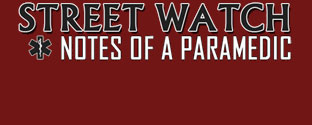In our state (Connecticut), BLS (with sponsor hospital approval) can do the following life-saving interventions:
Defibrillate with AED
Give Epinephrine in Anaphylaxis
Apply CPAP to Severe Respiratory Distress
Give Narcan to Hypoventilating Opiate Overdoses
Give ASA to Chest Pain.
Transmit 12-lead ECG
Speed Trauma and Stroke Patients to the Hospital
Here’s what They Can’t Do:
Cardiovert Conscious Patient in VT
Give Epi IV for Refractory Anaphylaxis
Give Benzos to Seizing Patients
Give Benzos (and sometimes Haldol) to Crazy Violent Patients
Give NTG to Patients in Pulmonary Edema
Give Breathing Treatments to Wheezing Patients.
Perform a Surgical Airway in a Patient Without an Airway.
Give Fentanyl or Morphine to Patients with Broken Bones or Severe Abdominal Pain
Do a Needle Decompression for a Hypotensive Trauma Patient with No Lungs Sounds on One Side
Give D10 to Hypoglycemic Diabetics
Interpret 12-lead ECG and Call STEMI Alerts
Protect Airway with ET Tube or Alternative Advanced Airway
Use McGills to Clear Airway
Give Zofran to a Nauseous Patient.
Use Enhanced Education and Assessment Skills to Treat and Triage their Patients
What Does This Mean?
Here’s how many needle decompressions, and surgical cricothyrotomies I have done in the last 10 years. Zero.
Here’s how many needle decompressions I have done in the last twenty years. One. Surgical cricothyrotomies. Zero.
Here’s how many conscious people in VT I have cardioverted in the last four? One. How many in twenty years? Six.
While many years ago I used to intubate 12-20 times a year, I am lucky if I get 5 a year now. (I precept a lot so my preceptees and EMT students get first crack).
How many working cardiac arrests? Maybe eight a year nowadays. How many walk out of the hospital with full neurological function have I had in the last four years? Two. How many in my career (that I know about)? Not counting ones who coded in front of me and came around with a shock. Seven.
What saved most of these patients? With the exception of one they were all vfib codes who got bystander CPR and came around with defibrillation while still on scene. The one who wasn’t shocked was an asystolic heroin overdose who came around with epi.
How about choking patients have I had to use my McGills on to clear their airway? One.
How many anaphylactic patients have I given IV epi to? 0.
How many seizing patients have I given benzos to? A ton. I would guess 100 or more.
How many times have I had to take down violent patients with benzos? Again a ton. Over 50.
How many CHFers I have pounded NTG into? Once more a ton. At least a 100, maybe 200.
STEMI patients? Well, when I first started since we didn’t do 12-leads, it is hard to count, but I would say I do five to six a year. I have had many I d identify that the machine could not. (We did a study on this that shows the machine is right only half the time when it calls a STEMI and does not call about 30% that are STEMIs).
How many patients have I given pain and comfort meds too? How many days have I worked this job? I use my narcotics nearly every day, sometimes two or three times a day. And Zofran? There is no drug I use more, not even oxygen.
How many patients have I used my advanced education and assessment skills on? Every patient I see. It doesn’t mean I need to use it, it means I can spot someone who is really sick that the nonparamedic eye might not have seen.
Bottom Line:
So despite the recent study —Outcomes of Basic Versus Advanced Life Support for Out-of-Hospital Medical Emergencies — I wrote about that looked at cardiac arrest, trauma, stroke and MI, and concluded ALS did not make a difference and may have been harmful, I have to state that I think ALS has value far beyond these calls.
Considering all the calls (as a full time paramedic since January 1995) I have done, I have saved relatively few lives. But as a paramedic, I have made a huge difference in people’s pain and comfort.
My contention is that our EMS system is fundamentally built around or should be built upon pain and comfort management. If someone is puking their guts out or has a broken leg or severe abdominal pain enough to require an ambulance, it is nice that here in America, we don’t throw people in the back of the donkey cart, or force them to ride the city bus with a vomit bucket. Now I know there are abusers, but I am not a judgmental guy. Fentanyl and Zofran have earned me more genuine thank yous that any number of cardiac arrests I have done.
NTG for CHF, Combivents for Asthma and COPD, Cardizem and Adenosine for SVTs, Versed for Severe Anxiety — these are all great thank you drugs. My old EMT instructor, Judy Moore, used to say, the emergency is over when you get to the scene. These drugs are about customer service. They called because they were in distress and you answered their call.
There are many more examples, but you get the gist. When someone calls for help, we ought to be able to help them. And ALS has a greater ability to answer that call than does BLS. That said, I support moving successful interventions down the line from ALS to BLS if the benefit outweighs the risk. I see no reason why Oral Zofran, Oral Bendryl, and Combivents can’t be BLS skills (I know Combivents are BLS in some areas). In an ideal world we would have even Fentanyl Lollipops at the BLS level, but I’ll save that argument for another day.
***
For True to Life EMS Fiction about Hartford EMS in the 1990’s (during the Latin gang wars), order Mortal Men Today.
Mortal Men: Paramedics on the Streets of Hartford


